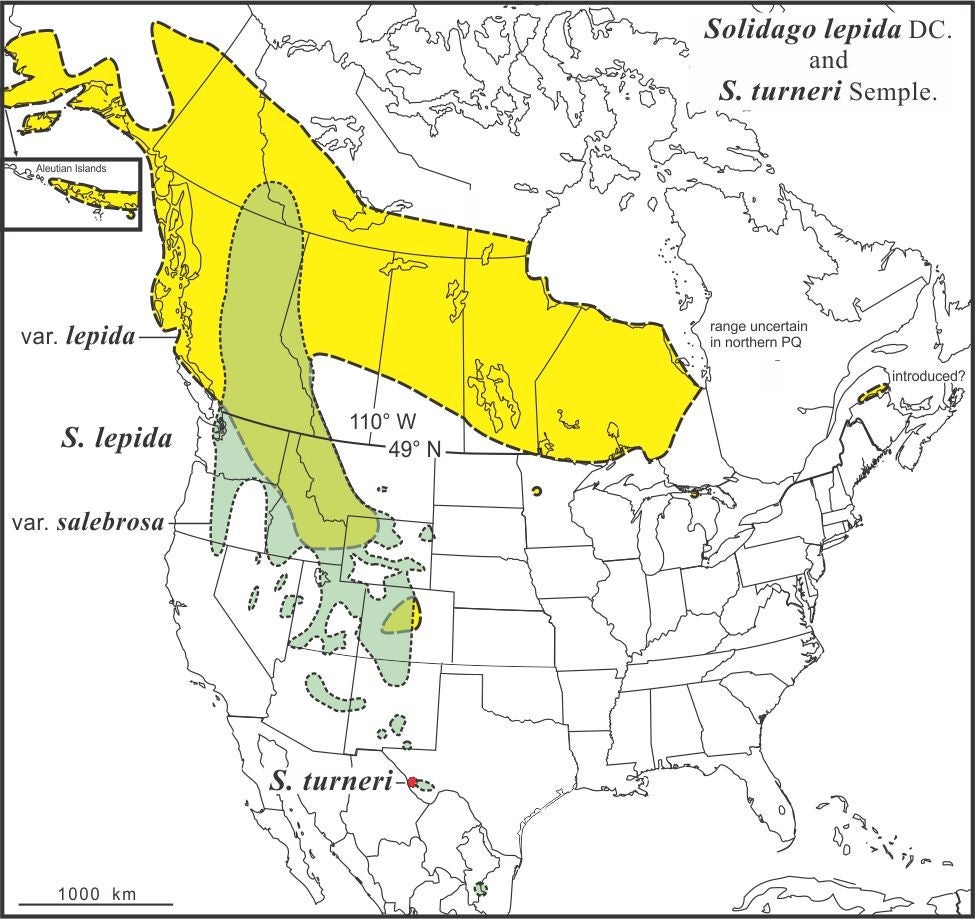Western Canada Goldenrod
Solidago lepida DC. is the most widely distributed species in subect. Triplinerviae occurring from Alaska across Canada to New Brunswick and south in the Rocky Mountains and Great Basin to northeastern Mexico. It is also the most morphological variable species in the subsect. Triplinervae. In FNA, the species was distinguished by being more glandular than other taxa in subsect. Triplinerviae (Semple & Cook 2006 FNA). Post-FNA research by the Asteaeae Lab indicates that this is not always the case and that diploids tend to be less glandular and have smaller glands than polyploids. Inflorescence branches are generally ascending and are usually leafy (accept in var. salebrosa). Leaves can be serrate, but can have few teeth or be entire. Forms of the species can be difficult to separate from S. bartramiana (synonym: S. brendae Semple; Semple 2023), S. canadensis and S. fallax in the eastern Canada, S. elongata in the west, and S. gigantea along its western range limits and on the northern Great Plains; hexaploids (2n=54) can be very similar in the two species.
In the Flora of North America treatment, Semple and Cook (2006) divided the species into a mostly western subsp. lepida and an eastern subsp. fallax (Fern.) Semple. Semple (2013) treated the eastern complex as S. fallax (Fern.) Semple. Semple et al. (2013) presented multivariate analyses supporting the revised classification. Semple et al. (2017) presented a multivariate study of the S. lepida complex in western North America comparing S. altissima var. gilvocanescens, S. elongata, S. gigantea and S. lepida; S. canadensis was included in the analysis but is not native to western North America.
Two varieties were compared in Semple et al. (2017) and are recognized in S. lepida:
- var. lepida (leafy inflorescence with ascending branches)
- var. salebrosa (non-leafy inflorescence with spreading arching branches)
The details of the ranges of the varieties are still being investigated. The distribution of the species in northern Mexico is not yet resolved. A draft version of the range is presented here.

The cytogeography of Solidago lepida was presented by Semple and Chmielewski (2022) who included the numerous counts of the species made by J.K. Morton (Morton et al. 2022). Three ploidy levels occur over much of the western range of the species: diploid, tetraploid, and hexaploid (2n=18, 36, 54) in both varieties, while only diploids and hexaploids occur in central (native) and eastern Canada (likely introduced).
Semple, J.C. 2013. A new species of Triplinerviae goldenrod in eastern Canada (Asteraceae: Astereae): Solidago brendiae. Phytoneuron 2013-57: 1–9.
Semple, J.C., H. Faheemuddin, Y.A. Chong, M.K. Sorour, J.A. Hood, I. Khamis, Y. Ma, and K. Kornobis. 2013. A multivariate morphometric study of the Solidago canadensis / S. lepida complex of Solidago subsect. Triplinerviae. I. Northeastern taxa (Asteraceae: Astereae). Phytoneuron 2013-58: 1–20.
Semple, J.C., H. Faheemuddin, M. Sorour, and Y.A. Chong. 2017. A Multivariate studies of Solidago subsect. Triplinerviae in western North America: The Solidago lepida complex (Asteraceae: Astereae). Phytoneuron 2017-47: 1–43.
Morton, J.K., J. Venn and J.C. Semple. 2022. Chromosome number determinations in Solidago brendae, S. canadensis, S. fallax, and S. lepida (Asteraceae: Astereae). Rhodora 123: 345–352.
Semple, J.C. and J.G. Chmielewski. 2022. Cytogeography of Solidago ser. Canadenses (Asteraceae: Astereae): S. brendae, S. canadensis, S. elongata, S. fallax, S. lepida, S. rupestris, S. shortii, and S. turneri. Phytoneuron 2022-57. 1-17.Semple, J.C. 2023. On Solidago bartramiana, S. brendae, and S. canadensis (Asteraceae: Astereae). Phytoneuron 2023-29: 1–9.
Last revised 14 April 2025 by J.C. Semple
© 2025 J.C. Semple, including all photographs unless otherwise indicated